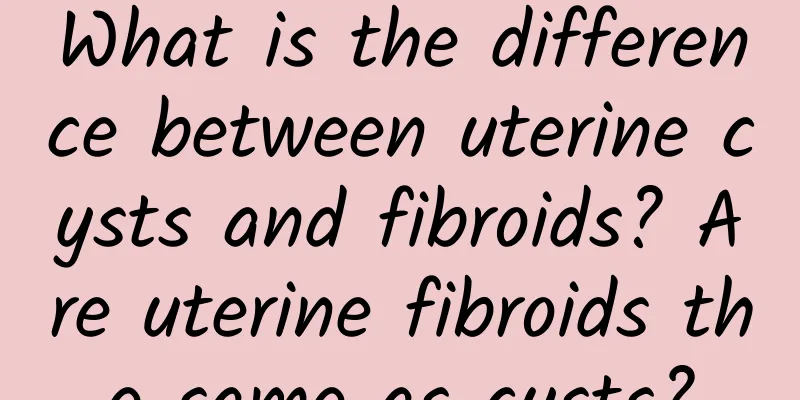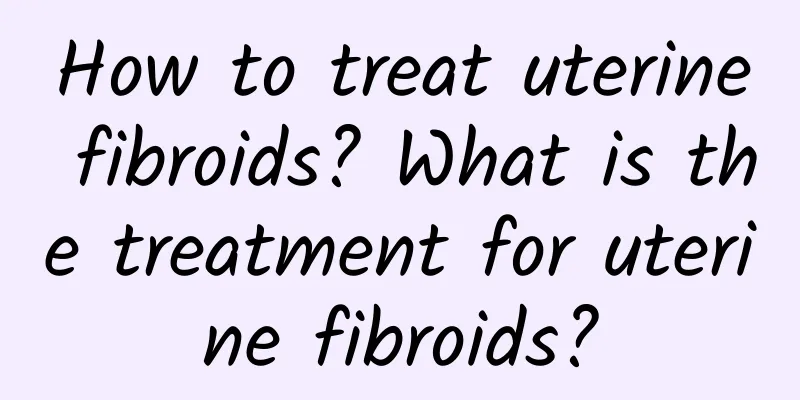What is the difference between uterine cysts and fibroids? Are uterine fibroids the same as cysts?

|
What is the difference between uterine cysts and fibroids? Are uterine fibroids the same as cysts? Among the common gynecological diseases, uterine cysts and fibroids are two common problems. Although both problems are related to the uterus, they are actually different. This article will discuss the differences between uterine cysts and fibroids in detail. 1. Different types: Uterine fibroids, also known as adenomyosis, refer to endometriosis lesions that can produce glandular lesions and myopathies in other structures in or around the uterus. Uterine fibroids are just lumps in the uterine muscle layer and are benign tumors. 2. Different symptoms: Symptoms of uterine cysts are usually irregular menstruation, pelvic pain, infertility, etc. Due to the presence of glandular lesions and myopathy, endometriosis and difficulty in embryo implantation may occur. Uterine fibroids usually present with menorrhagia, prolonged menstruation, menstrual pain, etc., but most patients do not have obvious symptoms. 3. Different impacts: Uterine cysts may bring physical and psychological burdens to patients. For women who are eager to get pregnant, it may lead to infertility and even an increased risk of ectopic pregnancy. Uterine fibroids usually do not hinder conception unless the location and size of the fibroids significantly hinder embryo implantation and uterine expansion. If the fibroids are large, they can compress the bladder and rectum, causing difficulty in urination and defecation. 4. Different palpation: In gynecological examination, uterine cysts may cause abnormal sensations of cystic enlargement and increase of the uterus. However, uterine fibroids can be clearly observed as thickening of the uterine wall and round or oval mass in B-ultrasound examination. 5. Different causes: At present, the cause of uterine cysts is still unclear. Some studies believe that it is related to genetic factors, immune abnormalities and endocrine disorders. Uterine fibroids are related to the increase of female estrogen levels and usually improve after menopause. There are obvious differences between uterine cysts and fibroids in terms of type, symptoms, effects, palpation and causes. Although both are common gynecological diseases, they require targeted treatment. If you suspect that you have uterine cysts or fibroids, be sure to see a doctor in time and receive a doctor's examination and advice. |
>>: What are the effects of a 2mm uterine fibroid? Do 2mm uterine fibroids need to be treated?
Recommend
We should pay attention to the common symptoms of ovarian cysts as early as possible
Among female diseases, ovarian cysts are relative...
How to prevent cervical erosion in women? Three points to note when preventing cervical erosion
Gynecological diseases are common to women. There...
What are the symptoms of vaginitis?
What are the symptoms of vaginitis? 1. Symptoms a...
What is the duration of pelvic inflammatory disease treatment?
The treatment time of pelvic inflammatory disease...
What are the symptoms of vaginitis in pregnant women?
There are many classifications of vaginitis, such...
What are the side effects of mifepristone?
Mifepristone tablets are a drug used by early pre...
Fight monkeys for food! Three creative ways to eat nutritious bananas
What is the best food to maintain health in the Y...
6 small folk remedies that are effective in treating constipation
[Introduction] Amenorrhea refers to a condition i...
Can improper sexual life cause vaginitis? Why is vaginitis so easy to recur?
Vaginitis is a more difficult gynecological disea...
How to relieve dysmenorrhea at the age of 12
Many women have suffered from menstrual pain. Men...
"Ox" turns things around! 3 tips for home exercise to help you exercise at home and improve your ability to prevent the spread of the virus
In order to prevent the new coronavirus pneumonia...
How many days after a miscarriage is it normal to be clean?
After a miscarriage, such as a spontaneous aborti...
What are the symptoms of uterine fibroids? What are the key points of uterine fibroids?
Gynecological diseases often become an important ...
What are the diseases that cause habitual abortion?
Habitual miscarriage has a huge impact on women&#...
What are the dangers of pelvic peritonitis to women?
Pelvic peritonitis causes obvious symptoms in pat...









